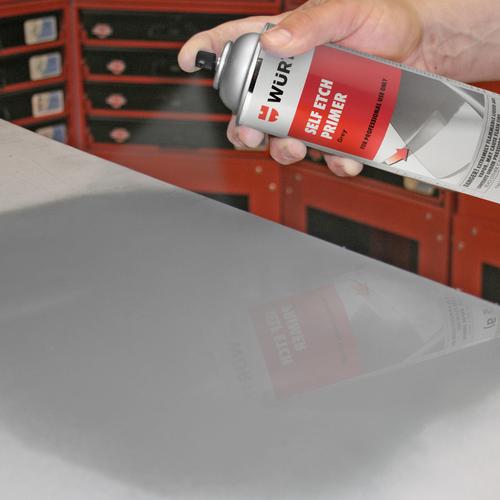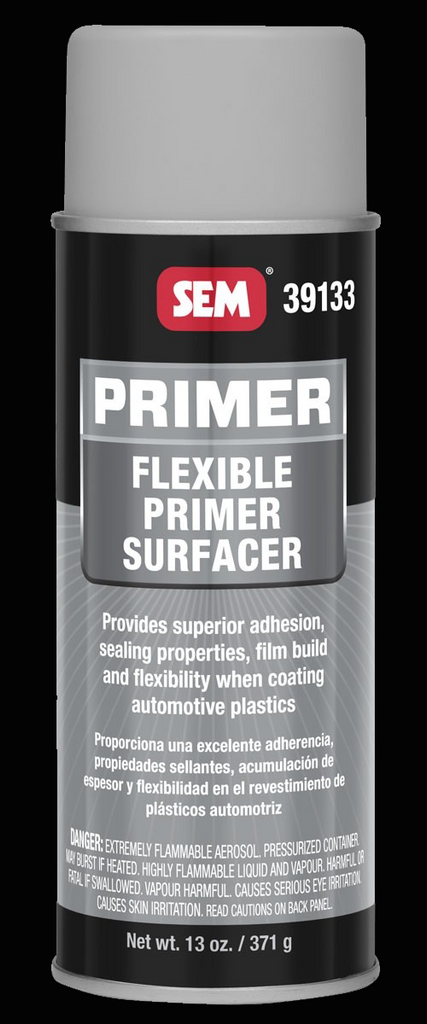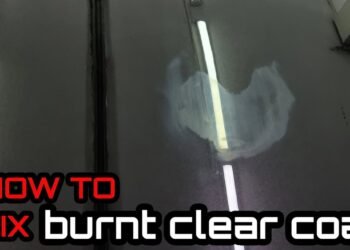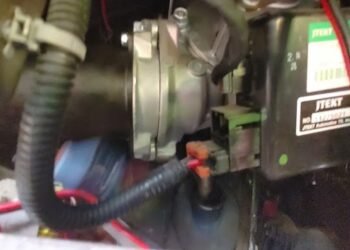Are you planning to paint plastic surfaces and wondering if self-etching primer is the right choice? You might have heard that etch primers work wonders on metal, but what about plastic?
Using the wrong primer can ruin your project by causing wrinkles or peeling paint. That’s why it’s crucial to know which primers truly bond well with plastic and how to prepare your surface for lasting results. You’ll discover why standard self-etching primers often fail on plastic, what alternatives work best, and how to get a smooth, durable finish every time.
Keep reading to make sure your next plastic painting job looks flawless and stands the test of time.
Self-etching Primer Basics
Self-etching primer is a special type of coating used before painting. It helps paint stick better on metal surfaces by creating a rough texture. This primer contains acidic chemicals that slightly etch the surface, making it easier for paint to bond. Understanding the basics of self-etching primer is important for proper use, especially on different materials like plastic.
How It Works
Self-etching primer contains acid that lightly corrodes the surface. This process creates tiny grooves for paint to hold onto. The primer also acts as a protective layer against rust and corrosion on metals. It dries quickly and forms a strong base for the topcoat paint. This helps ensure a smooth and durable finish.
Common Uses
Self-etching primer is mainly used on bare metal surfaces. It is popular in automotive repairs and metal fabrication. It prepares steel, aluminum, and other metals for painting. This primer is also used on some metal tools and outdoor equipment. It is not generally recommended for plastics or non-metal materials.
Limitations On Plastic
Self-etching primer usually does not work well on plastic. The acid can damage plastic surfaces, causing wrinkling or peeling. Plastic needs special primers designed to stick without harming the material. Using standard self-etching primer on plastic can ruin the finish. Always choose a primer made specifically for plastic surfaces.

Credit: us.amazon.com
Challenges With Plastic Surfaces
Plastic surfaces present unique difficulties when applying primers. Their smooth, non-porous nature resists paint adhesion. Many traditional primers do not bond well to plastic. This often leads to peeling or flaking after drying.
Plastic can also be sensitive to harsh chemicals in primers. This sensitivity causes damage or discoloration. Proper surface preparation and the right primer choice are essential for success. Self-etching primers are designed to tackle some of these challenges.
Why Standard Etch Primer Fails
Standard etch primers contain acids meant for metal surfaces. These acids do not react well with plastic. Plastic lacks the microscopic texture metals have for primer bonding. As a result, the primer does not stick properly. It often peels off quickly under stress.
Surface Damage Risks
Some primers can degrade plastic surfaces. Acidic components may soften or crack the material. This damage weakens the plastic’s structure. It can cause bubbling or discoloration under the paint. Using the wrong primer risks ruining the entire project.
Wrinkling And Texture Issues
Wrinkling happens when primer dries unevenly on plastic. Plastic’s smooth surface can cause primer to pool or clump. This creates an uneven texture under the paint. The final finish looks rough and unprofessional. Careful application and suitable primers reduce these problems.
Selecting The Right Primer
Selecting the right primer is crucial for painting plastic surfaces. The wrong primer can cause peeling, cracking, or poor adhesion. Picking a primer designed for plastics ensures a smooth, long-lasting finish. Understanding different types of primers helps you make the best choice for your project.
Plastic-specific Primers
Plastic-specific primers contain special ingredients that bond well with plastic. These primers create a strong base for paint to stick. They prevent peeling and improve durability. Use these primers on plastic parts to get better results.
Adhesion Promoters
Adhesion promoters help paint stick to tricky surfaces like plastic. They work by creating a rougher surface at the microscopic level. This allows the primer and paint to grip better. Applying an adhesion promoter before priming enhances the overall bond.
Compatibility Tips
Check the primer label to ensure it suits your plastic type. Some primers work better on flexible plastics, others on rigid ones. Always test the primer on a small plastic area first. This prevents damage and shows how well the primer adheres.

Credit: sliplo.shop
Surface Preparation For Plastic
Proper surface preparation is key for applying self-etching primer on plastic. Plastic surfaces often have smooth finishes that reduce primer adhesion. Preparing the surface correctly helps the primer bond well and improves paint durability. It also prevents peeling and uneven finishes on plastic parts.
This section explains the essential steps to prepare plastic surfaces before applying a self-etching primer. Each step focuses on cleaning, removing contaminants, and ensuring proper adhesion. These steps will help achieve a smooth and lasting finish.
Cleaning And Sanding
Start by cleaning the plastic surface with mild soap and water. This removes dust and loose dirt. Dry the surface completely before sanding.
Use fine-grit sandpaper, around 400 to 600 grit. Sand the surface gently to create a rough texture. This helps the primer stick better. Avoid deep scratches or damage to the plastic.
Removing Contaminants
Plastic surfaces often have oils, grease, or mold release agents. These prevent primer adhesion. Use a plastic-safe degreaser or rubbing alcohol to remove these contaminants. Wipe the surface with a clean cloth until it feels dry and clean.
Do not touch the cleaned surface with bare hands. Oils from skin can reduce adhesion. Use gloves or a clean cloth during handling.
Ensuring Proper Adhesion
After cleaning and sanding, check the surface for smoothness and dryness. The surface should feel slightly rough but clean. Apply the self-etching primer in thin, even coats.
Follow the primer manufacturer’s instructions for drying time. Proper drying allows the primer to bond well with the plastic. Avoid rushing this process to prevent peeling or bubbling.
Application Techniques
Applying self etching primer on plastic requires careful technique for the best results. Proper application ensures good adhesion and a smooth finish. Understanding the right methods helps avoid common problems and improves durability.
Spray Vs Brush
Spraying self etching primer on plastic gives an even coat. It covers hard to reach areas quickly. Use smooth, steady motions to avoid drips. Hold the spray can about 6 to 8 inches from the surface.
Brushing is slower but offers more control. Use a high quality brush with soft bristles. Apply thin, even layers to prevent brush marks. Brushing works well on small or detailed parts.
Layering And Drying Times
Apply multiple thin layers rather than one thick coat. Thin layers dry faster and reduce runs. Wait about 10 to 15 minutes between coats. Check the primer’s label for exact drying time.
Allow the final layer to dry completely before sanding or painting. Proper drying prevents peeling and ensures strong adhesion. Room temperature and humidity affect drying speed.
Common Mistakes To Avoid
Do not apply primer on dirty or oily plastic. Clean the surface thoroughly before starting. Avoid heavy coats that cause bubbling or wrinkling. Do not skip sanding for better grip.
Use standard etch primer cautiously on plastic. It may damage the surface or cause wrinkles. Choose a primer designed specifically for plastic materials. Follow all safety guidelines and use proper ventilation.
Two-step Priming Process
The two-step priming process ensures strong adhesion on plastic surfaces. It uses two different products applied in sequence. This method prepares the plastic for paint effectively. Each step plays a unique role in creating a durable bond. The process helps prevent peeling and flaking over time. Below is a detailed explanation of the two-step method.
Using Adhesion Promoter First
Start by applying an adhesion promoter to clean plastic. It improves the surface’s ability to hold the primer. This product creates a sticky base for the next layer. Use a light, even coat and let it dry fully. Adhesion promoters are specially made for plastic materials. They help paint stick better and last longer.
Applying Plastic Primer Next
After the adhesion promoter dries, apply the plastic primer. This primer adds extra protection and a smooth finish. It also seals the surface and improves paint bonding. Apply thin coats and allow each to dry well. Plastic primers are made to work with the adhesion promoter. This step ensures the paint will not peel or crack.
Benefits Of Two-step Method
This two-step process creates a stronger bond than using one product. It reduces the risk of paint failure on plastic surfaces. The layers work together to protect against moisture and wear. This method also improves the final paint’s appearance. It extends the life of painted plastic parts. Using both products gives a reliable, lasting finish.
Popular Products And Brands
Choosing the right self-etching primer for plastic surfaces helps ensure strong adhesion and a smooth finish. Various brands offer primers designed to bond well with plastic materials. These products also act as adhesion promoters to prepare the surface for painting. Understanding popular options can guide your purchase and improve your project results.
Top Self-etching Primers For Plastic
Rust-Oleum Self Etching Primer is a trusted choice for many DIYers. It provides a durable base on plastic parts and metal. Dupli-Color Self-Etching Primer offers excellent adhesion and quick drying time. SEM Self Etching Primer is popular in automotive circles for its reliable bonding and corrosion resistance. Eastwood Self-Etch Automotive Primer is ideal for car restoration and plastic repairs.
Recommended Adhesion Promoters
Some primers work best with adhesion promoters for plastic surfaces. TCP Global Corp Custom Shop Premium Self Etching Acid Etch Primer combines etching with adhesion promotion. Ortho Technology S.E.P Self Etching Primer Pro Kit includes both primer and adhesion enhancer. These products improve paint durability and reduce peeling risks. Using adhesion promoters helps prepare slick plastic for better paint grip.
Where To Buy
Major retailers stock these popular primers both online and in stores. Home Depot and Walmart often carry Rust-Oleum Self Etching Primer. O’Reilly Auto Parts offers Dupli-Color and SEM Self Etching Primers. Advance Auto Parts stocks SEM primers as well. Online platforms like Amazon provide a wide selection with user reviews. Check local auto supply stores for specialized brands and kits.
Troubleshooting Adhesion Problems
Troubleshooting adhesion problems with self-etching primer on plastic requires careful attention. Poor adhesion reduces the durability and finish quality of your project. Understanding the causes helps fix issues quickly and efficiently.
Identifying Poor Adhesion
Look for peeling, flaking, or bubbling on the primer surface. These signs indicate weak bonding between the primer and plastic. Check if the surface feels rough or smooth after priming. A smooth surface may mean the primer did not etch properly. Also, test small areas by scratching gently to see if the primer comes off easily.
Fixing Surface Imperfections
Clean the plastic surface thoroughly using soap and water or a plastic cleaner. Remove all dust, grease, and oils before priming. Lightly sand the plastic with fine-grit sandpaper to create texture for better adhesion. Avoid heavy sanding that damages the plastic. After sanding, wipe the surface with a tack cloth to remove dust.
Reapplication Tips
Apply the self-etching primer in thin, even coats. Allow each coat to dry completely before adding the next. Avoid over-saturating the surface to prevent runs and bubbles. Spray from the recommended distance to ensure proper coverage. Store the primer in a cool, dry place to maintain its quality for future use.
Safety And Environmental Tips
Using self-etching primer on plastic requires careful attention to safety and environmental practices. These primers contain chemicals that can harm your health and the environment if not handled correctly. Following safety tips helps protect you and the surroundings while ensuring a clean, smooth finish on your plastic projects.
Proper Ventilation
Always work in a well-ventilated area. Open windows and doors or use fans to increase airflow. Avoid breathing in fumes from the primer. Proper ventilation reduces exposure to harmful vapors. This keeps the air safe to breathe and prevents dizziness or headaches.
Protective Gear
Wear protective gear before applying the primer. Use gloves to protect your skin from chemicals. Safety goggles shield your eyes from splashes. Consider a mask or respirator to avoid inhaling fumes. Protective gear lowers health risks during the application process.
Disposal Guidelines
Dispose of leftover primer and empty containers properly. Do not pour primer down drains or on the ground. Check local rules for hazardous waste disposal. Use designated collection points for chemical waste. Proper disposal prevents pollution and protects water sources.

Credit: rothmetalflake.com
Frequently Asked Questions
Does Self-etching Primer Stick To Plastic?
Standard self-etching primers usually do not stick well to plastic and may cause surface damage. Use plastic-specific primers instead.
What Primer Is Best On Plastic?
The best primer for plastic is a plastic-specific primer or adhesion promoter. Avoid standard self-etching primers, as their acids damage plastic surfaces. Choose primers labeled safe for plastic to ensure strong adhesion and prevent surface wrinkling or damage.
When Should You Not Use Self-etching Primer?
Avoid using self-etching primer on plastic unless labeled safe for plastic. Standard etch primer can cause wrinkling and damage. Use plastic-specific primers or adhesion promoters for best results.
Can You Use Any Primer On Plastic?
Standard etch primers can damage plastic due to their acid content. Use primers specifically made for plastic or plastic adhesion promoters for best results. Always check product labels to ensure compatibility with plastic surfaces before application.
What Is Self-etching Primer On Plastic Used For?
Self-etching primer helps paint stick better to plastic surfaces by slightly roughening them.
Conclusion
Self etching primer on plastic helps paint stick better and last longer. Choose a primer made for plastic to avoid damage. Applying it correctly improves the finish and durability. Always read the label to ensure compatibility with your surface. Using the right primer saves time and effort in the long run.
A good primer creates a strong base for paint on plastic parts. This simple step can make a big difference in your project’s success.

















